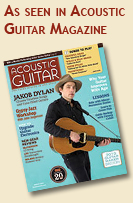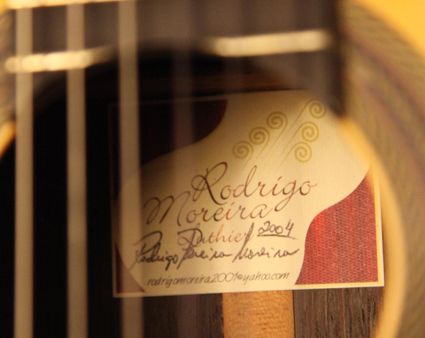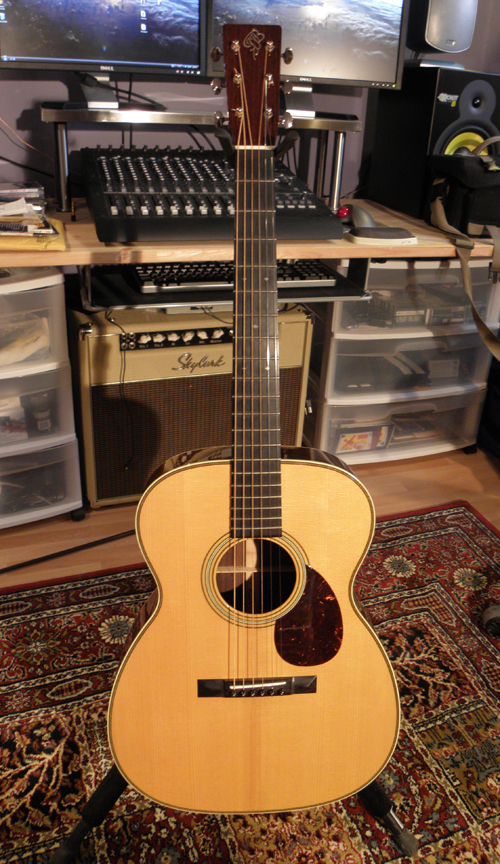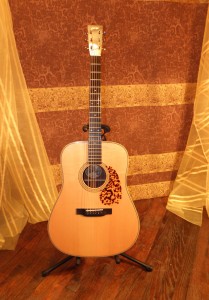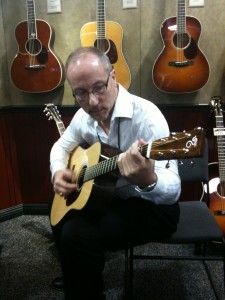Archive for the ‘AO1 Process’ Category
NAMM Week Update: AAL Releases AO1 Process Details & New Products For 2011
PITTSBURGH, – Alchemy acoustic Labs, LLC (AAL) has made optimizing acoustic instruments their top priority since 2007. In addition to having applied their proprietary AO1 process to a great number of pre-existing acoustic instruments with a 100% success rate since launching the service, AAL has continually pursued new routes to acoustic instrument optimization. In 2010, AAL expanded their AO1 process to the mandolin and violin markets. In 2011 they will release more results of those efforts as well as a more thorough discussion of the process itself.
With information gained by their experience and research on the AO1 process, inventor Frank Sanns has now developed a physical device that will greatly enhance the tonal and response properties of acoustic instruments and give luthiers more design freedom when designing and building their instruments. The new device is patent-pending and will be available both as a standalone, aftermarket accessory and as an integral component on new instruments. AAL has begun collaborative work with key artists & manufacturers in the acoustic instrument market. Plans to unveil private and licensable prototypes will roll-out in the second quarter of 2011.
This month, in response growing interest in their efforts, AAL has released a new level of details about their proprietary, patent-applied-for AO1 acoustic optimization service via their website, https://alchemyacousticlabs.com.
After an instrument arrives at AAL, the AO1 Process begins by a thorough visual inspection followed by sonic and tactile impressions made by one or more guitar techs and/or players.
After the initial evaluation is completed, the instrument is placed in an anechoic chamber and a proprietary sensor system maps the input and output response of the primary sound forming surfaces of the instrument. The I/O response is then used to establish unique process parameters that will be implemented on each individual instrument. Just as no two instruments are the same, the AO1 process is custom calibrated for every instrument.
Once the process parameters are mapped, various locations of the instrument are targeted and then are non-thermally annealed by focusing high energy sonic waves of extremely specific energy levels at corresponding specific locations on the instrument while response measurements are tracked simultaneously.
The AO1 process allows for symmetrical, properly located oscillations to occur in the sound-forming surfaces of the instrument and manifests itself in greater volume/dynamic range, richer, more full sound, and greater responsiveness to the player’s touch. Over the course of the following 4-6 weeks, the instrument will continue to transform to its full 100% potential assisted by frequent playing.
AAL has processed instruments for multiple large-scale manufacturers and modified versions of the AO1 process are available for manufacturer’s licensing.
AAL in Acoustic Guitar Magazine
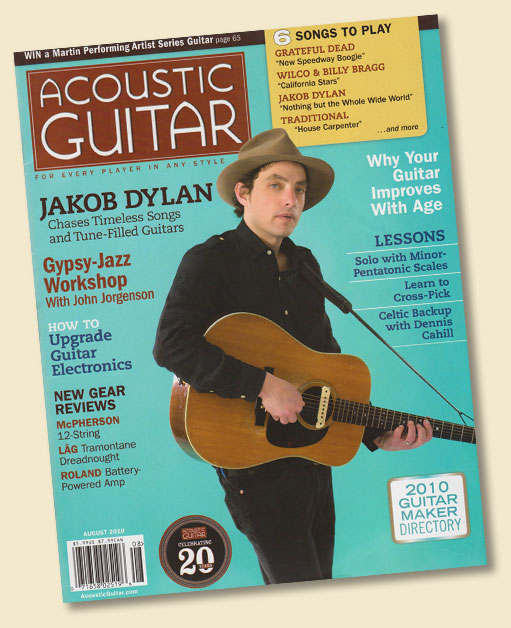 AAL was mentioned in a sidebar to a great article about guitar aging by Robert Johnston in the August issue of Acoustic Guitar Magazine.
AAL was mentioned in a sidebar to a great article about guitar aging by Robert Johnston in the August issue of Acoustic Guitar Magazine.
We bring this up not so much as a promotional vehicle for us (don’t get me wrong, we’d work it if we could find a way, but it was only a name drop, not a cover story!) as much as to point out a well-structured bit of journalism about a topic near and dear to our hearts here. The article discusses the properties of aging that directly contribute to the changing of an acoustic guitar’s sound.
A quote from the article:
“There is no question that stringed instruments change as they’re aging and are getting played. On some instruments, the changes people detect are dramatic, while on others they’re more subtle, making it difficult to predict the sound a new guitar will deliver in the future. For these reasons, it’s best to not count on specific tonal improvements when purchasing a new guitar, but rather to choose one that sounds great to you now; think of anything else as icing on the cake!”
Which is a seemingly obvious yet, surprisingly crucial statement that we firmly support. What we’ve said about our process from the beginning, that it’s YOUR guitar, only moreso – is still behind everything we do. We wouldn’t have the level of customer satisfaction that we do now (100% by the way) if we made people’s guitars sound like other guitars. You picked your guitar out with emotion and great care. What we do is to take your guitar to ITS fullest potential. Not make it sound like something it wasn’t meant to be, but rather exactly what it WAS designed to be, someday in the future.
We’re happy just being mentioned in the article, even if it is in the same breath as a couple device-based gizmos that throw a wacky one-size-fits-all, “Flowbee” shroud over the science of what we do. (It’s okay, we understand. $149 is hard to pass up. We’re not saying they don’t work, in um – their own way. Talk to us about it sometime.)
One thing the article talks about that we wish we had the chance to respond to formally is this notion that even in the best lab testing they’ve devised, these are super-subtle effects that human auditory memory can’t even discern between because ear memory dissipates so quickly – yadda, yadda. Um, respectfully – no. Maybe if you’re trying to compare two “same” guitars (note – the author does allow that no two guitars are ever truly the same, but they still used the reports from the test) or sticking an aquariam vibrator on your guitar for a 100 hours, or just asking unassociated players which guitar tone they like better – you’ll get some varying results that could be attributed to the poor human ear memory. But we haven’t had one customer yet report back anything less than dramatic transformation in volume, balance, sustain etc. from our process. In fact, it’s been blogged about independently out in the world. More importantly, we’ve captured and graphed those unsubtle differences with our data measuring equipment. let me go further and add what we’ve said all along – if any notable publication (like AGM, for example) wants AAL to put our money where our mouths are – we’ll process a guitar for free for their scrutiny, or take part in a test or shootout.
Let’s talk.
Rodgrigo Moreira Hauser Replica
Frank brings the freshly AO1-optimized Rodrigo Moreira Hauser replica classical guitar back to Porsche specialist John Raysich, at his repair shop (John Raysich Porsche Specialties) in Pittsburgh, PA.
This guitar has an interesting story. Moreira was commissioned to do some restoration work on Segovia’s 1931 Hauser I guitar. Having one, if not THE most prized classical guitars in the world in hand, Moreira decided to build a replica or two….
It’s February, which was pretty brutal this year in Pittsburgh, and John was busy at work, in coveralls, with beepers and phones ringing and mechanics asking him questions while he tried the guitar for the first time after being processed. So – as usual, we present a very candid, un-glamorous look at REAL customers’ REAL reactions when they get their instruments back.
Elambo’s Julius Borges OM-28
We offered to do one guitar for one member of the online Collings Forum community free of charge. The recipient selection process took some time, but in the end we decided to go with one of the moderator’s guitars. Elambo is an audio engineer, studio musician and the furthest thing from an AAL cheerleader we could find. We wanted an objective opinion. We’re posting our results and opinions before Elambo does, in an effort to be as forthright as possible. Let the chips fall.
The Julius Borges OM-28 was one of our favorite guitars we’ve ever played or had in our labs. The build quality and playability is just phenomenal. It was already optimized for volume, versatility and projection by design when we received it.
Post AO1 process, it did not come up as dramatically in amplitude (volume) as some other guitars we’ve processed. It had more increase in sustain than volume. But where we felt that the process enhanced its sound the most was in the evening out of the notes, filling in the bottom end in the lows and low-mid ranges. It truly opened up the guitar in the way that age and playing (a lot) would do.
We’ll post updates to this guitar as the story continues to unfold. For now, here are some audio and video files chronicling the event.
Audio Files:
Elambo’s Borges (Before A01 Process 01)
Audio clip: Adobe Flash Player (version 9 or above) is required to play this audio clip. Download the latest version here. You also need to have JavaScript enabled in your browser.
Elambo’s Borges (After A01 Process 01)
Audio clip: Adobe Flash Player (version 9 or above) is required to play this audio clip. Download the latest version here. You also need to have JavaScript enabled in your browser.
Elambo’s Borges (Before A01 Process 02)
Audio clip: Adobe Flash Player (version 9 or above) is required to play this audio clip. Download the latest version here. You also need to have JavaScript enabled in your browser.
Elambo’s Borges (After A01 Process 02)
Audio clip: Adobe Flash Player (version 9 or above) is required to play this audio clip. Download the latest version here. You also need to have JavaScript enabled in your browser.
David Grissom’s Collings D2H
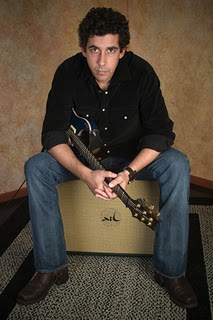 Legendary Austin session guitarist David Grissom (John Mellencamp, Dixie Chicks, Bob Dylan, Buddy Guy, Chris Isaak etc.) talked with us at the 2010 Winter NAMM show about having one of his guitars processed. In early March, Collings shipped us his D2H to get the AO1 treatment.
Legendary Austin session guitarist David Grissom (John Mellencamp, Dixie Chicks, Bob Dylan, Buddy Guy, Chris Isaak etc.) talked with us at the 2010 Winter NAMM show about having one of his guitars processed. In early March, Collings shipped us his D2H to get the AO1 treatment.
From the moment it arrived, we all liked the guitar very much, but according to David, it was his least favorite of his three Collings dreads. We heard the opportunity to help it reach its full potential and were eager to let the process do what we expected it would.
You can watch the video below (or on the Videos page) of Jim Relja and us examining the guitar before and after the process. The process added much more sustain and it really filled out the frequency range in the lows and low-mids.
One of our usual go-to reviewers, Jim was knocked out by both this guitar and by how it transformed after being processed. “I’ve never heard sustain like this on a guitar. This is ridiculous…”
We sent the guitar back to Collings and waited for David to get back from the road to check it out. His immediate responses were good, but he waited a few weeks to give us his full review:
“The process has made a noticeable change in my guitar. It always sounded good, but was my least favorite of my 3 Collings Dreads. Now it seems louder and punchier, and doesn’t “cave in” at all when played really hard…..and holds it’s own with the other guitars which happen to be exceptional. Thank you again.”
David Grissom
Austin, TX
April 15, 2010
Audio files are HERE
Bourgeois Advanced Slope D Madrose
When one of your biggest problems is that every time your business partner goes out he comes back with a new lovely guitar – well let’s just say there are worse problems to have.
We’re extremely lucky to have one of the best-stocked high-end acoustic guitar shops in the country, manned by one of the most knowledgeable, passionate guitar dealers in the business, right here about 5 miles up the river from our headquarters. We have no connection with Steve from Acoustic Music Works, (other than being regular customers) but I can tell you his hand-picked instrument selection is unsurpassed.
We see our share of off-the-charts high-end guitars through here and I have to say that Bourgeois makes some of the finest playing instruments available. Frank chose this gorgeous Bourgeois Advanced Slope D Premium Madrose from Steve’s stock because of its stunning tone and beauty. This is a player’s guitar.
This video is another casual behind the scenes discussion with Jim Relja playing and reviewing the guitar directly after it had been AO1-processed. the guitar has since opened up even more in the 4 weeks since this video was shot. You’ll hear one of our returning customers, Pat, asking Jim questions about the process in this clip.
Some days I have the best job on the planet.
Maui’s Collings D2H MRA Varnish Top
We’ve got a lot going on right now, but this also qualifies as news. In case you haven’t seen it, we’ve been part of a rather lengthy and spirited thread on the Online Collings Forum. I have enjoyed participating in it and answering as many questions as I can. We have had a few guys from the forum call and schedule guitars to be sent in. This is the first of them. The guitar belongs to “Maui” in Hawaii and it was sent at probably the greatest personal expense so far (Calton cased guitar to and from Hawaii to Pittsburgh is not cheap) The thread on the forum is now 25 PAGES long and has been viewed over 7400 times at last count. With all those things in mind, we really felt like we were on the hotseat on this one so we recorded everything including our before and after commentary. As we have done all along, we’re not going to publish emails here but we’ll be happy to put anyone interested in the process in touch with the guitar’s owner or the player at any time, as long as they are open to being contacted. Please keep in mind, this is a more casual, shaky-cam style video intended for entertainment – not a discerning audiophile demonstration. There are new MP3 files of this guitar HERE and better quality .wavs are available upon request.
Back from NAMM
 Well, we had an exhausting but really worthwhile 4 days at the NAMM show in sunny Anaheim. We have been working to get some more instruments and models onto the website and will be putting up some new info soon. We also met with a few manufacturers of potential decal makers, but we’re still trying to find a material that Frank deems “non-sound-deadening” enough that will also not interact with nitrocellulose laquer. (We know we owe them to a bunch of you early AO1 customers)
Well, we had an exhausting but really worthwhile 4 days at the NAMM show in sunny Anaheim. We have been working to get some more instruments and models onto the website and will be putting up some new info soon. We also met with a few manufacturers of potential decal makers, but we’re still trying to find a material that Frank deems “non-sound-deadening” enough that will also not interact with nitrocellulose laquer. (We know we owe them to a bunch of you early AO1 customers)
We met and talked with so many exceptional builders and performing artists about sending us an instrument to put through the AO1 process, (you know who you are!) thanks to all of your overwhelmingly helpful input, advice, interest and/or participation, 2010 is looking like a big year for Alchemy Acoustic Labs.
AO1-Optimized James Olson SJ
Newest addition to our growing stable of different amazing guitars that have gone through our AO1 process: According to its owner, this James Olson SJ style guitar is exactly like the Olson that James Taylor owns and plays except for the inlay design. This Cedar-topped, Eastern Rosewood back and sides SJ (small jumbo) model guitar produced by Jim Olson is favored by James Taylor, Phil Keaggy, David Wilcox, Patty Larkin, David Crosby and many other top level artists.
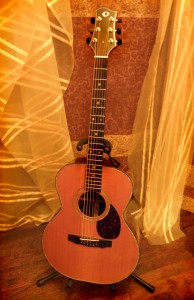 We just completed the AO1 process on this guitar. Sound files are available below and on the Audio Page. As great as this guitar sounded before, it sounds even better now. The quote from the control room from Jim Relja was “More sustain. More volume and balance, and just way more fun to play than before. There was a dramatic difference between the before and after performance of the guitar.”
We just completed the AO1 process on this guitar. Sound files are available below and on the Audio Page. As great as this guitar sounded before, it sounds even better now. The quote from the control room from Jim Relja was “More sustain. More volume and balance, and just way more fun to play than before. There was a dramatic difference between the before and after performance of the guitar.”
As always, we stress that the guitars that we receive are all different and they are among the nicest sounding instruments on the planet. We are not altering the voicing of these instruments, we are just making them more of what they are, or what they will be – many years down the line – right now.
Olson SJ Track 01 (Before AAL A01 Process)
Audio clip: Adobe Flash Player (version 9 or above) is required to play this audio clip. Download the latest version here. You also need to have JavaScript enabled in your browser.
Olson SJ Track 01 (After AAL A01 Process)
Audio clip: Adobe Flash Player (version 9 or above) is required to play this audio clip. Download the latest version here. You also need to have JavaScript enabled in your browser.
Apologies to J. T. but this just seemed fitting:
Olson SJ Track 02 (Before AAL A01 Process)
Audio clip: Adobe Flash Player (version 9 or above) is required to play this audio clip. Download the latest version here. You also need to have JavaScript enabled in your browser.
Olson SJ Track 02 (After AAL A01 Process)
Audio clip: Adobe Flash Player (version 9 or above) is required to play this audio clip. Download the latest version here. You also need to have JavaScript enabled in your browser.
Here’s the response from the owner:
Having had time to spend a few weeks with the SJ Olson you processed for me – the biggest difference is not so much the unplugged sound , yes that did improve.
It was the feel of the instrument that I most noticed. The improvements were not so much in tone, but in sustain, the bloom of the note and the subtle decay as the note fades to wherever they go.
Your process creates more time and space, which in turn, creates more options to interpret a song. Songs do not have to be pushed or hurried in anyway. A great guitar that already sounded good, now simply became more a more complicated platform in it’s options available to the player.
The tree became a guitar.
What makes a great guitar ?
The one that inspires you to pick it up.
Thanks Boys
Patric Dahms
Home Port , Pittsburgh 2010
